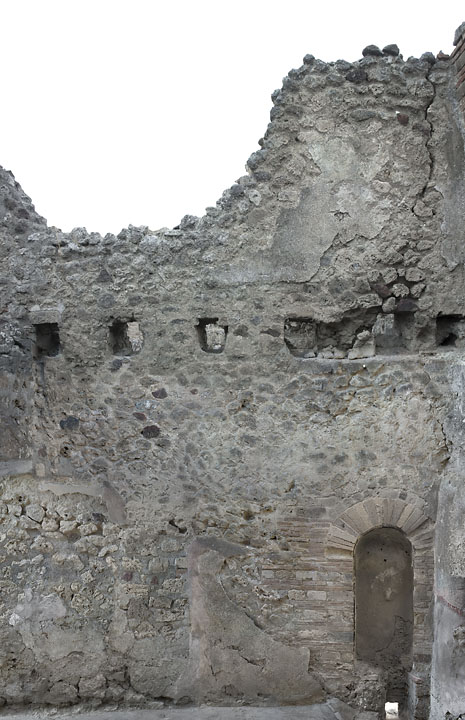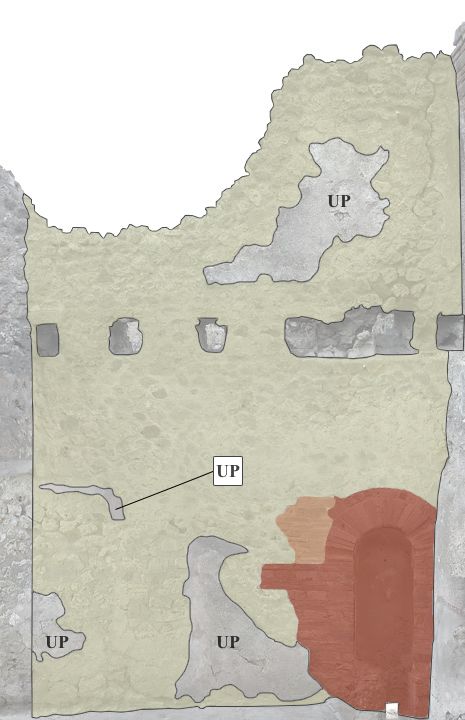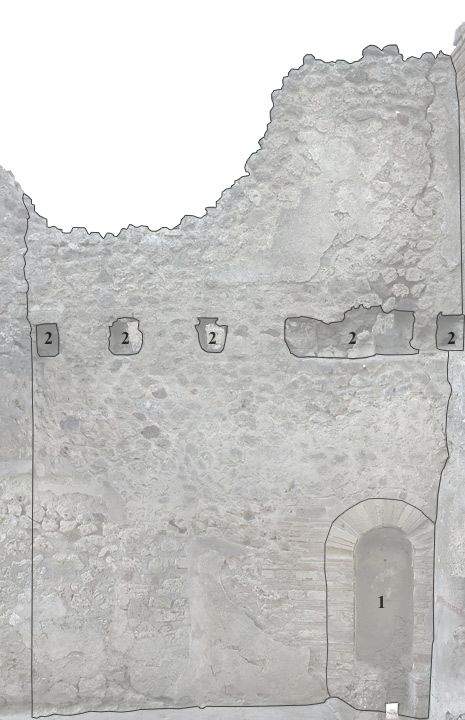North Wall
Description
Mats Holmlund
Ground floor
For the most part the wall is constructed in opus incertum-style. In the west corner by the latrine, the construction styles are opus listatum and opus testaceum. The incertum-part of the wall consists mainly of limestone and cruma, but it also contains some bits of tufa and lava. The listatum-part of the wall is made up of two rows of tiles alternated with one row of tufa, limestone or cruma. This construction style stretches from the floor level up until between 1.20 to 1.30 m from the ground, and there it changes to regular opus testaceum. The arc of the vault of the toilet niche is however also constructed in listatum-style, but an irregular one, where initially two tiles (counting from west) is followed by one piece of tufa and the next two tiles are followed by two pieces of tufa. Thereafter follows only one tile, which in its turn, is followed by four pieces of tufa. After that follows two pieces of tile and three pieces of tufa, followed by one tile and two tufa stones. At the end, the construction resumes the ordinary fashion of two rows of tiles, one tufa stone and another two rows of tiles.
There are some spolia in the wall. Circa 3.00 m from the east corner and 2.00 m from the ground, there are two small pieces of tile inte the wall. They measure 0.07 x 0.02 m and 0.04 x 0.02 m, and are placed after the other. Approximately 2.00 m from the east corner and 1.10 m from the floor level, there are another two pieces of tile in the wall. Since they are partly obscured by the band of modern mortar that keeps the fourth area of plaster in place, their width cannot be measured. They are, however, circa 0.03 m thick and placed on top of each other. There are also four stones with remains of plaster in the wall (i.e. either they are stones with plaster remains or reused stones). The first one (and most probable piece of spolia, since the plaster looks like it goes off in another angle than the expected vertical) is located circa 1.00 m from the east corner and 2.40 m from the floor level. The second is located 1.80 m from the corner and 2.60 m form the ground, the third, circa 1.90 m from the corner and 2.55 m from the floor level, and the fourth and last, is located 2.30 m from the east corner and circa 2.55 m from the ground.
The original mortar in the incertum-part of the wall is yellowish grey and contains grains of lava and limestone. The same goes for the listatum- and testaceum-parts of the wall, with the small difference that the mortar in these parts also contains some grains of terracotta. By the west end of the wall, there is some modern, dark grey mortar applied to the wall. The area starts 3.70 m from the east corner of the room and stretches approximately 1.60 m into the room (that is 2.10 m from the east corner). In the west the area begins circa 1.20 m from the floor level and continues to 1.60 m from the ground. At its east end, it starts at circa 0.80 and ends 1.50 m from the floor level. West of the toilet to the left of the listatum-part of the wall, there is and area where the yellowish grey mortar has been covered by plaster until relatively recently. In this area the mortar looks a little more brown or beige, and it is still possible to identify markings from the appliance of the mortar to the wall. Even tough the mortar appears to be brown in hue; it is the same yellowish grey one.
There are six areas where plaster or the subsurface of plaster remains on the wall. The first one is located circa 3.50 m from the east corner of the room and stretches circa 1.60 m eastward into the room. It begins between 0.10 and 0.25 m from the floor level and ends circa 1.00 m from the ground. No plaster remains in this area, only the subsurface of it, and it is partly held in place in both ends by modern pinkish grey mortar. The second area is located 3.30 m from the east corner and 1.90 m from the floor level. The patch is approximately 0.10 x 0.03 m and consists of plaster subsurface. It is held in place by an L-shaped area of modern grey mortar that also holds the third patch of plaster subsurface in place. This patch is located 2.80 m from the east corner and 1.80 m from the floor level. The area measures circa 0.08 x 0.08 m. The fourth area begins circa 1.00 m from the east corner and ends 2.00 m from it. It stretches from the floor level up until circa 1.35 m from the ground. At its west end the plaster subsurface held in place by modern pinkish mortar (this stripe if modern mortar continues beyond the plaster area and a bit of it sticks to the wall between the listatum- and testaceum-part of the wall by the toilet, thus indicating that the fourth plaster area originally covered that space to). The fifth area of plaster is in the east corner of the room. It starts circa 0.65 m from the floor level and ends 1.00 m from it. At its widest point it is circa 0.07 m wide. This area of plaster subsurface belongs to a larger area on the east wall. Above the area circa 1.70 to 2.05 m from the floor level, there is some modern pinkish mortar applied to the wall. The sixth area of plaster subsurface is inside the toilet niche (see the description of the toilet).
Upper floor
The wall is constructed in opus incertum-style and consists of limestone, lava, and cruma.
There are six beam holes in the wall. They are between 0.22 and 0.25 m wide and circa 0.30 m high, and the distance between them is circa 0.40 m (except for the sixth beam hole by the east corner, that only measures 0.16 m wide, 0.30 m high and is located only 0.20 m from the fifth one). There is a crack in the wall that begins above the fifth beam hole circa 0.55 m from the east corner and it continues up to the top of the wall, ending circa 0.10 m from the east corner. There is a modern repair above the first beam hole.
The mortar seems to be of the same yellowish grey kind (containing grains of lava and limestone) that makes up the mortar of the first floor.
Two areas of plaster subsurface remain on the wall. The first stretches from circa 0.40 to 1.80 m from the east corner of the wall and from approximately 3.50 to 4.55 m from the floor level. The other area is in the east corner. It starts circa 3.60 m from the floor level and ends about 4.75 m from it and is circa 0.15 m wide at its widest point.



